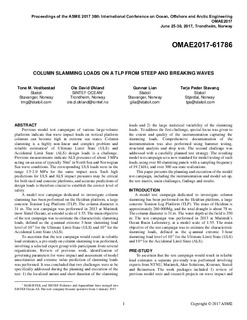| dc.description.abstract | Previous model test campaigns of various large-volume platforms indicate that wave impact loads on vertical platform columns can become high in extreme sea states. Column slamming is a highly non-linear and complex problem and reliable estimation1 of Ultimate Limit State (ULS) and Accidental Limit State (ALS) design loads is a challenge. Previous measurements indicate ALS pressures of about 3 MPa acting on an area of typically 50m2 in North Sea and Norwegian Sea wave conditions. The corresponding ULS loads were in the range 1.5–2.0 MPa for the same impact area. Such high predictions for ULS and ALS impact pressures may be critical for both steel and concrete platforms, and accurate predictions of design loads is therefore crucial to establish the correct level of safety. A model test campaign dedicated to investigate column slamming has been performed on the Heidrun platform, a large concrete Tension Leg Platform (TLP). The column diameter is 31 m. The test campaign was performed in 2013 at Marintek (now Sintef Ocean), at a model scale of 1:55. The main objective of the test campaign was to estimate the characteristic slamming loads, defined as the q-annual extreme 3-hour slamming load level of 10−2 for the Ultimate Limit State (ULS) and 10−4 for the Accidental Limit State (ALS). To ascertain that the test campaign would result in reliable load estimates, a pre-study on column slamming was performed, involving a selected expert group with participants from several organizations. Review of previous work, identification of governing parameters for wave impact and assessment of model uncertainties and extreme value prediction of slamming loads was performed. It was concluded that two challenges were to be specifically addressed during the planning and execution of the test: 1) the localized nature and short duration of the slamming loads and 2) the large statistical variability of the slamming loads. To address the first challenge, special focus was given to the extent and quality of the instrumentation capturing the slamming loads. Comprehensive documentation of the instrumentation was also performed using hammer testing, structural analysis and drop tests. The second challenge was addressed with a carefully planned test strategy. The resulting model test campaign set a new standard for model testing of such loads, using over 80 slamming panels with a sampling frequency of 19.2 kHz, and over 300 sea state realizations. This paper presents the planning and execution of the model test campaign, including the instrumentation and model set-up, the test matrix, main challenges, findings and results. | nb_NO |
